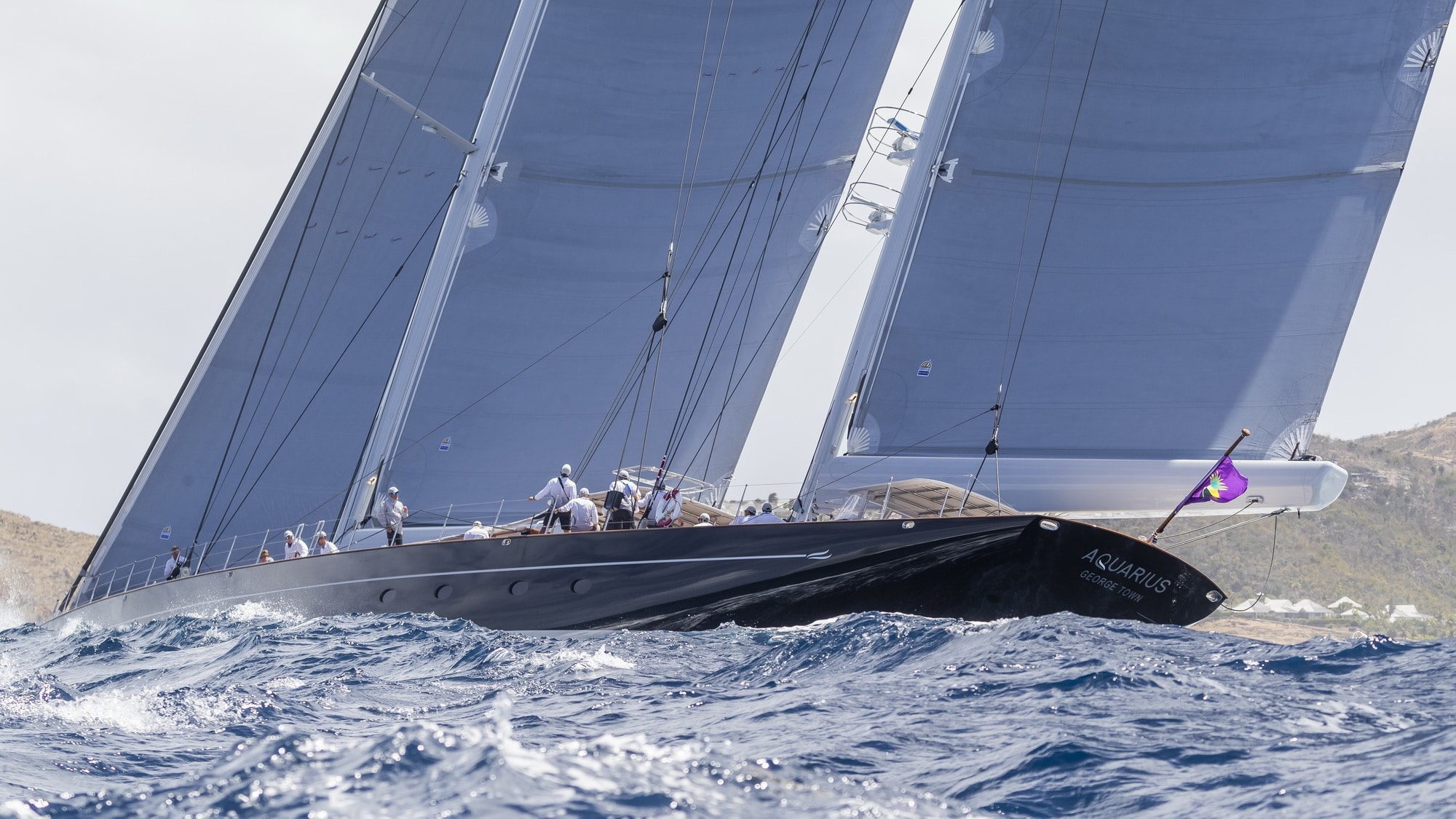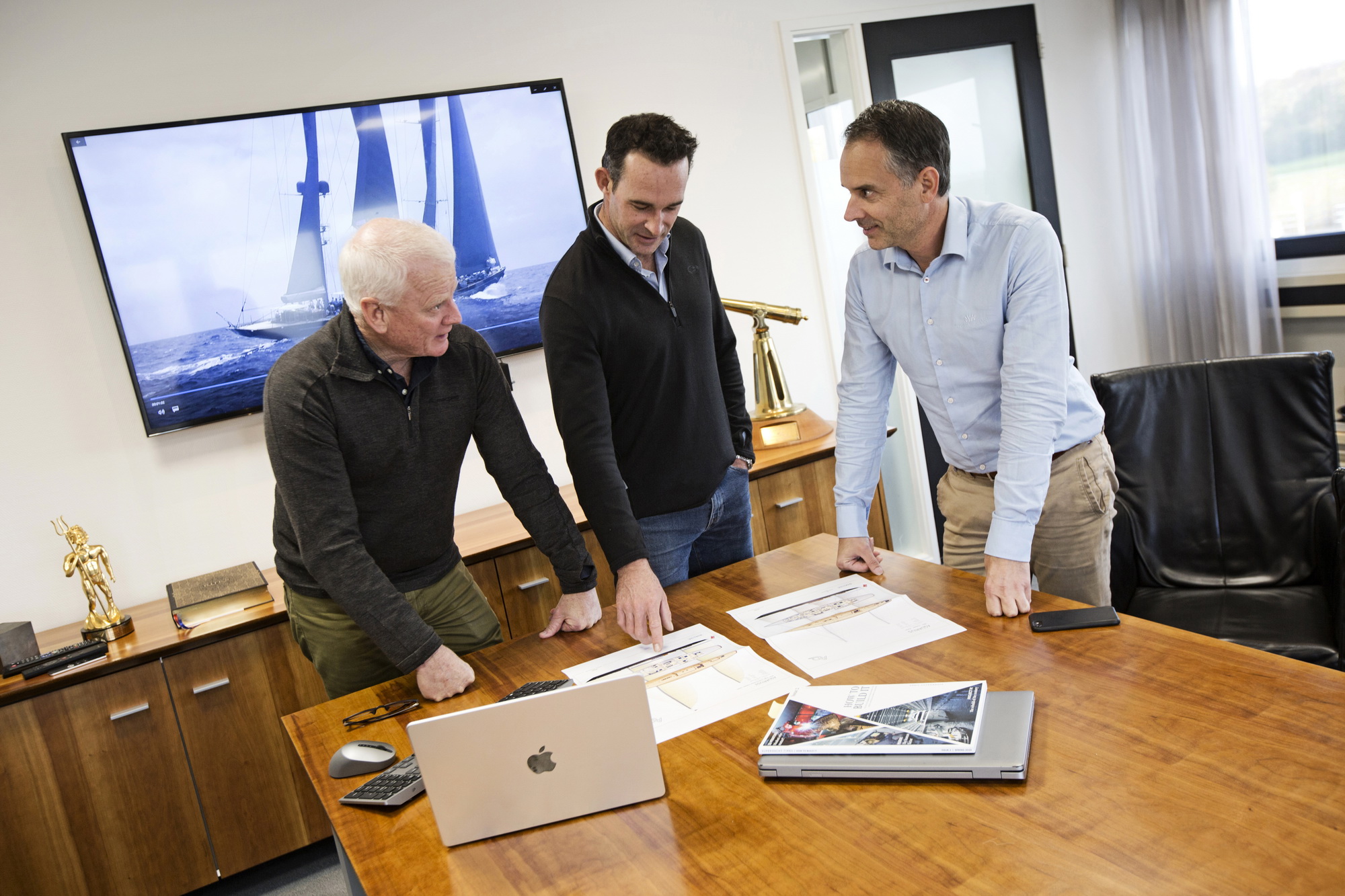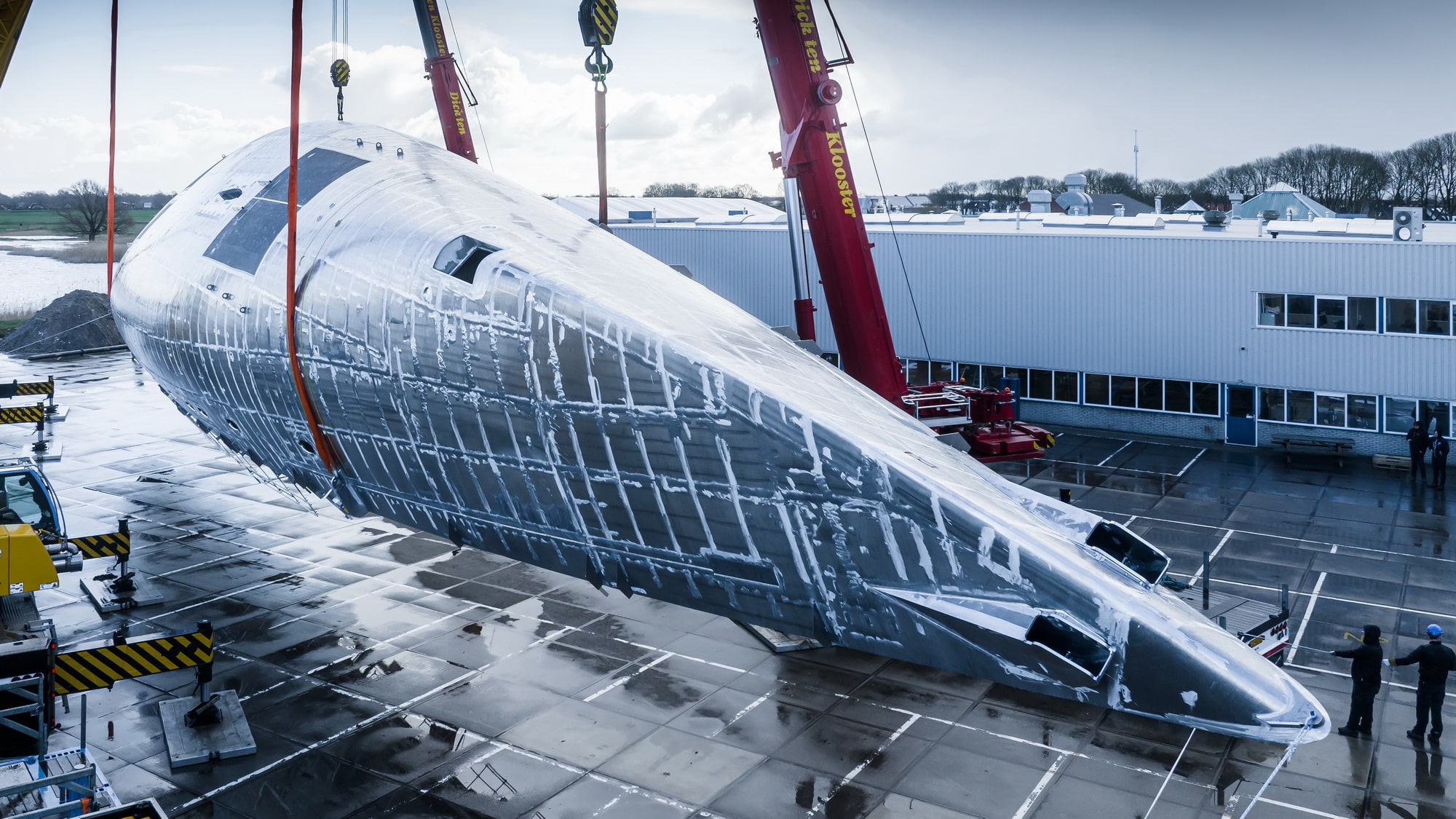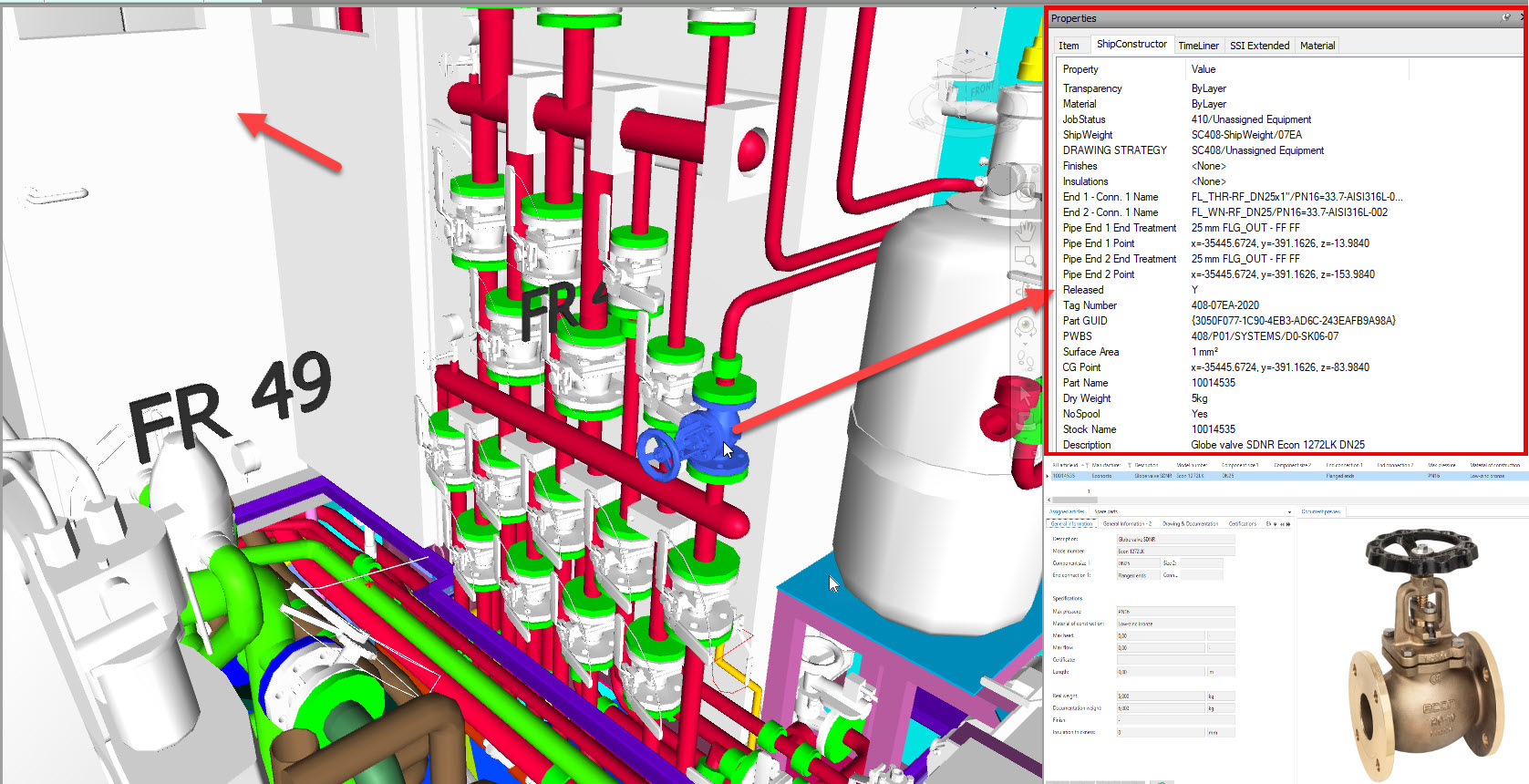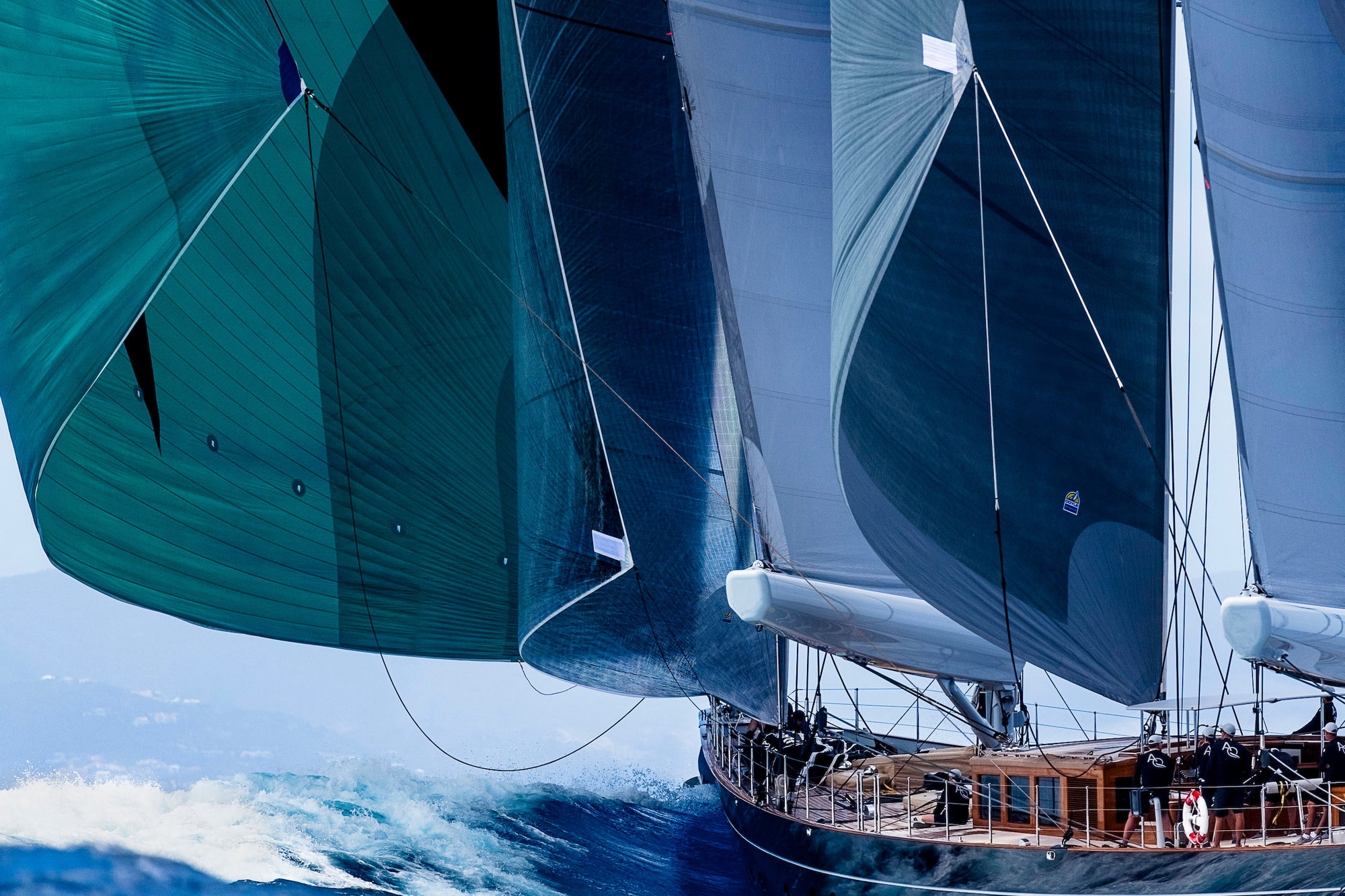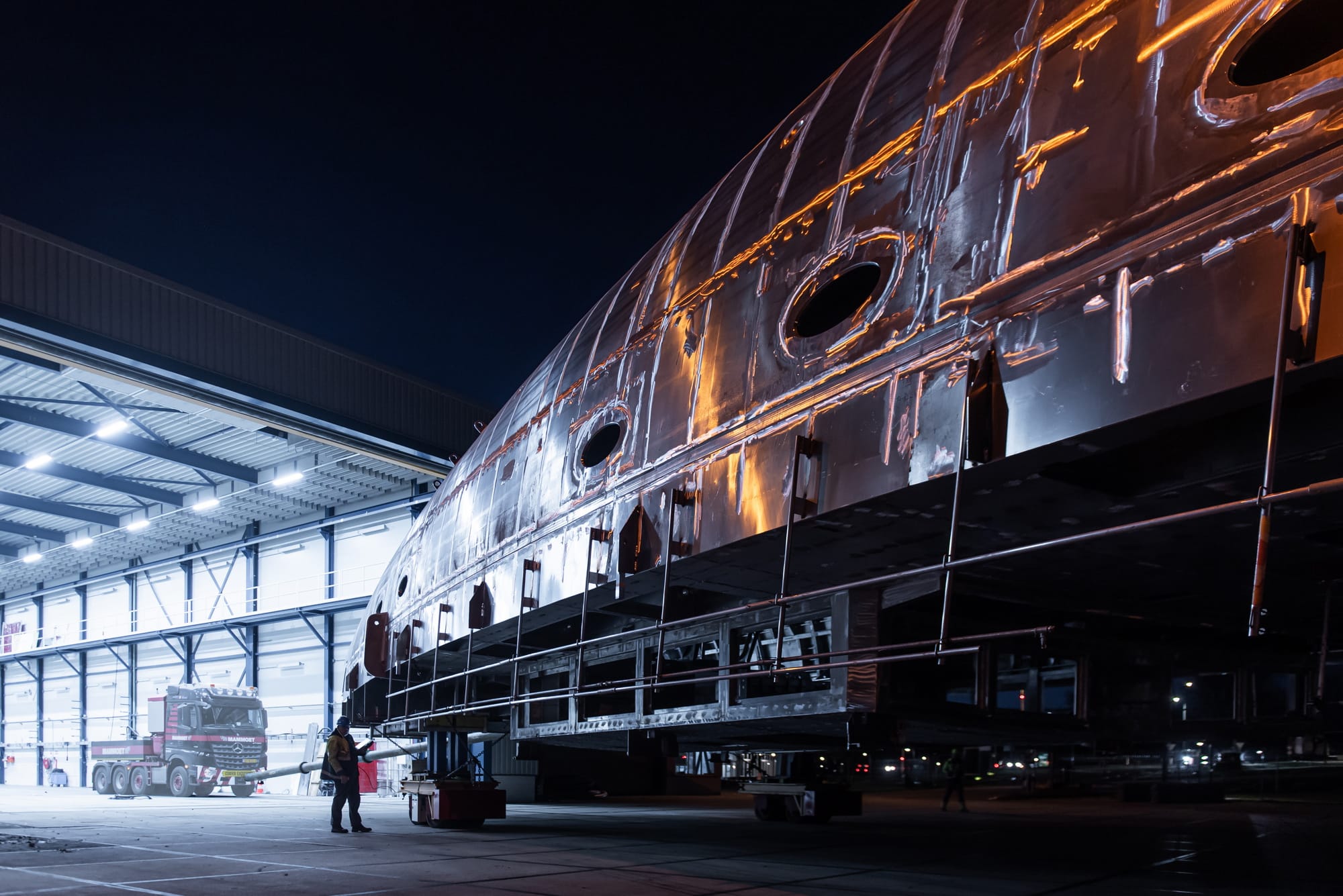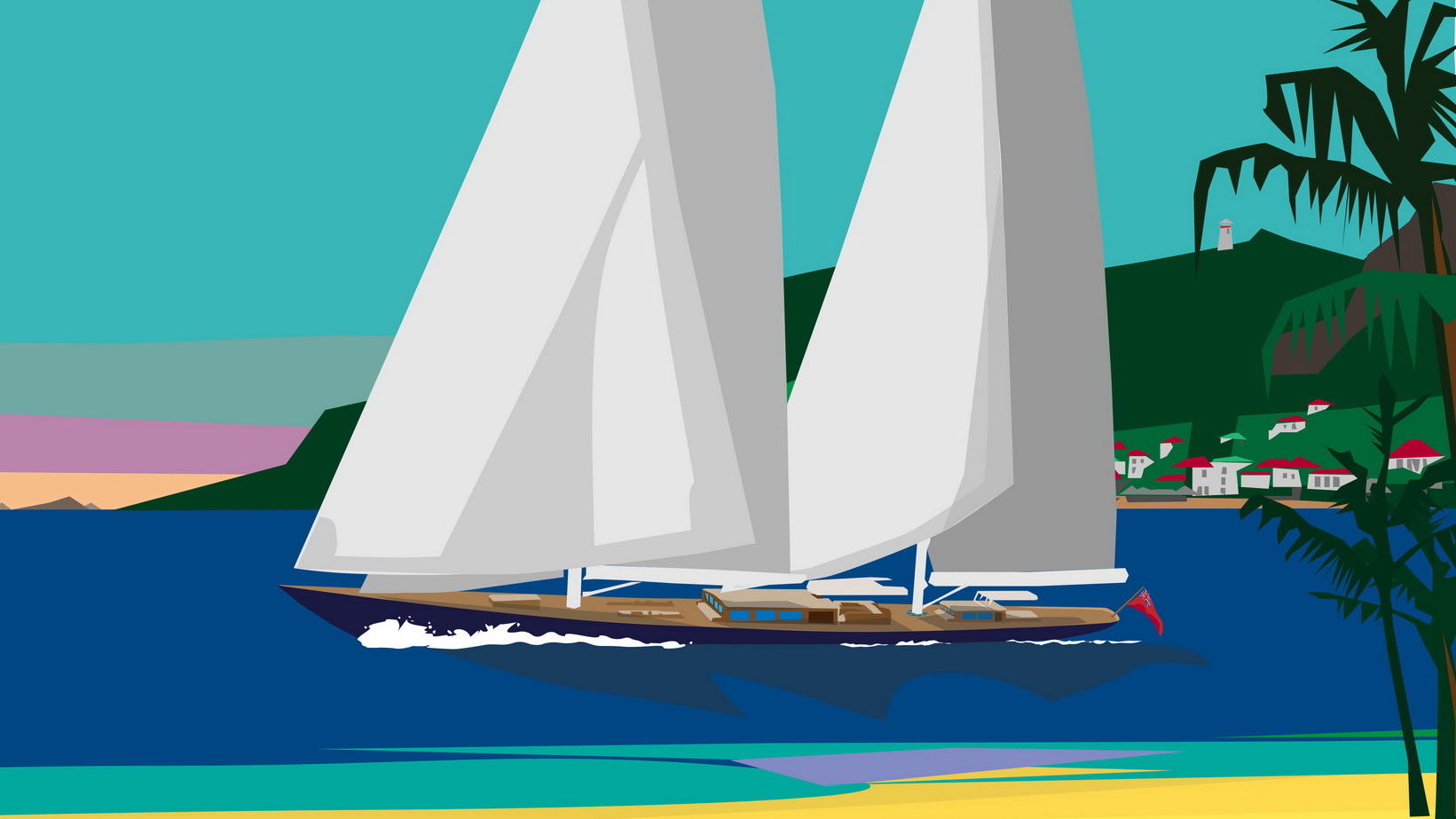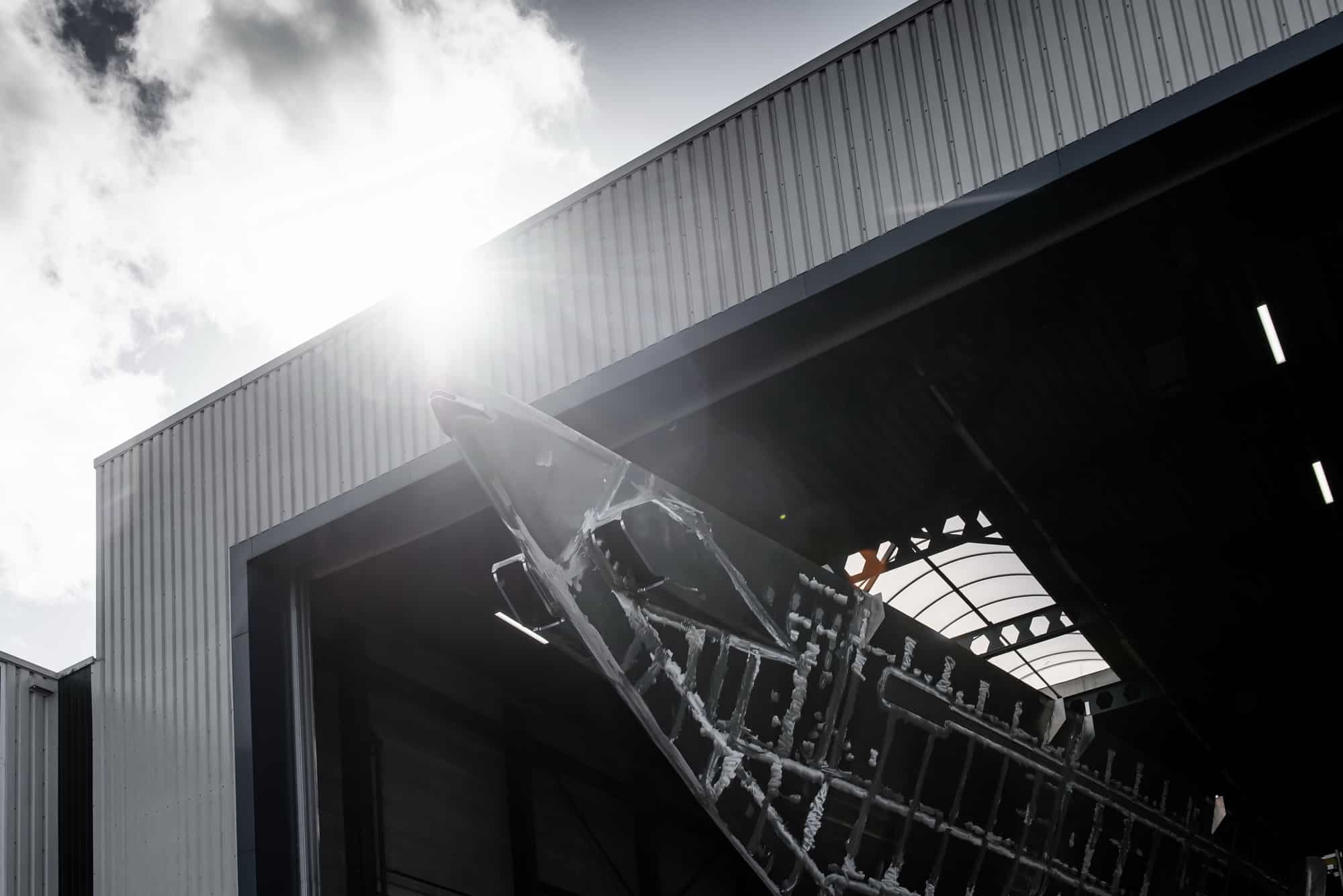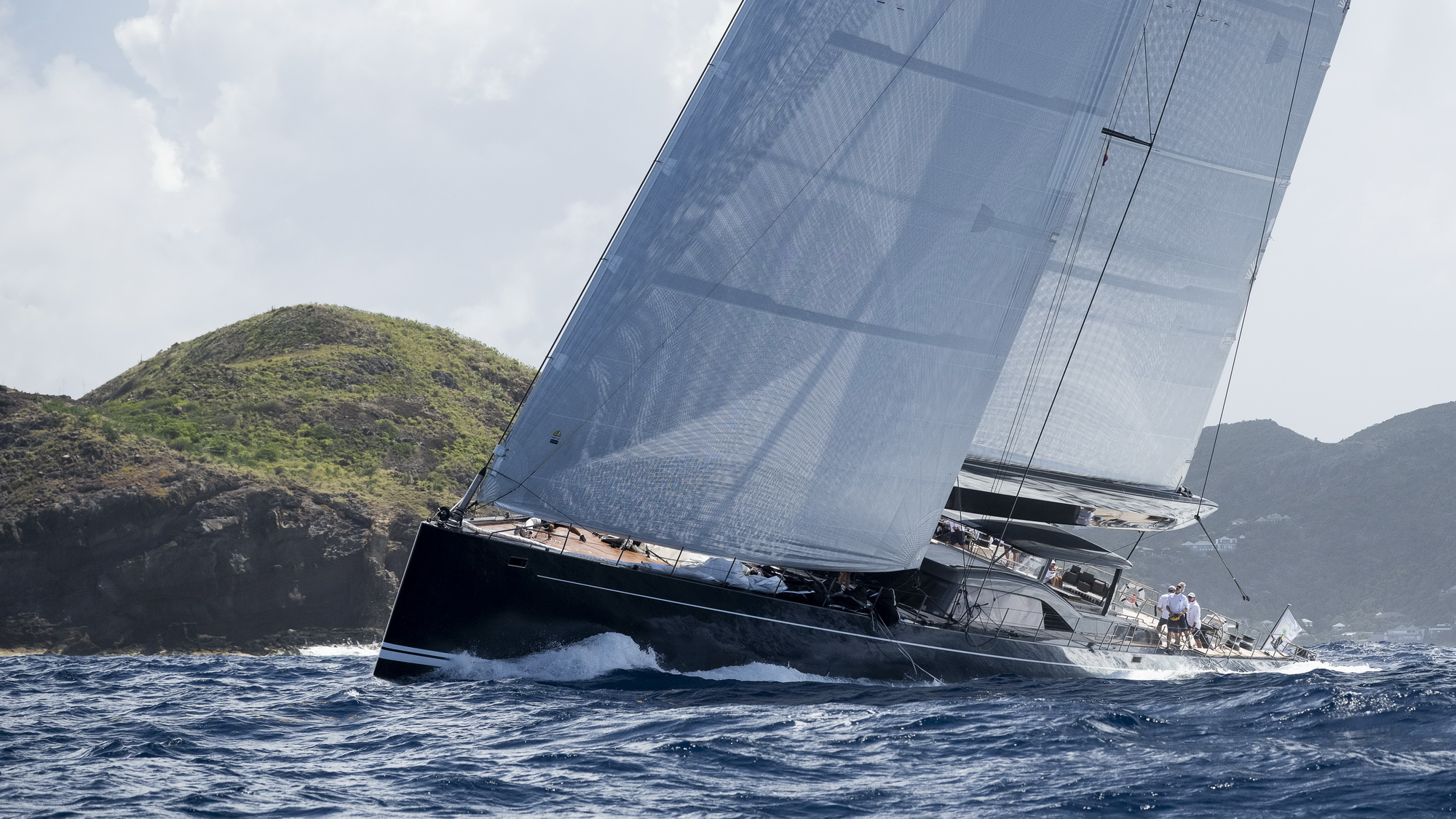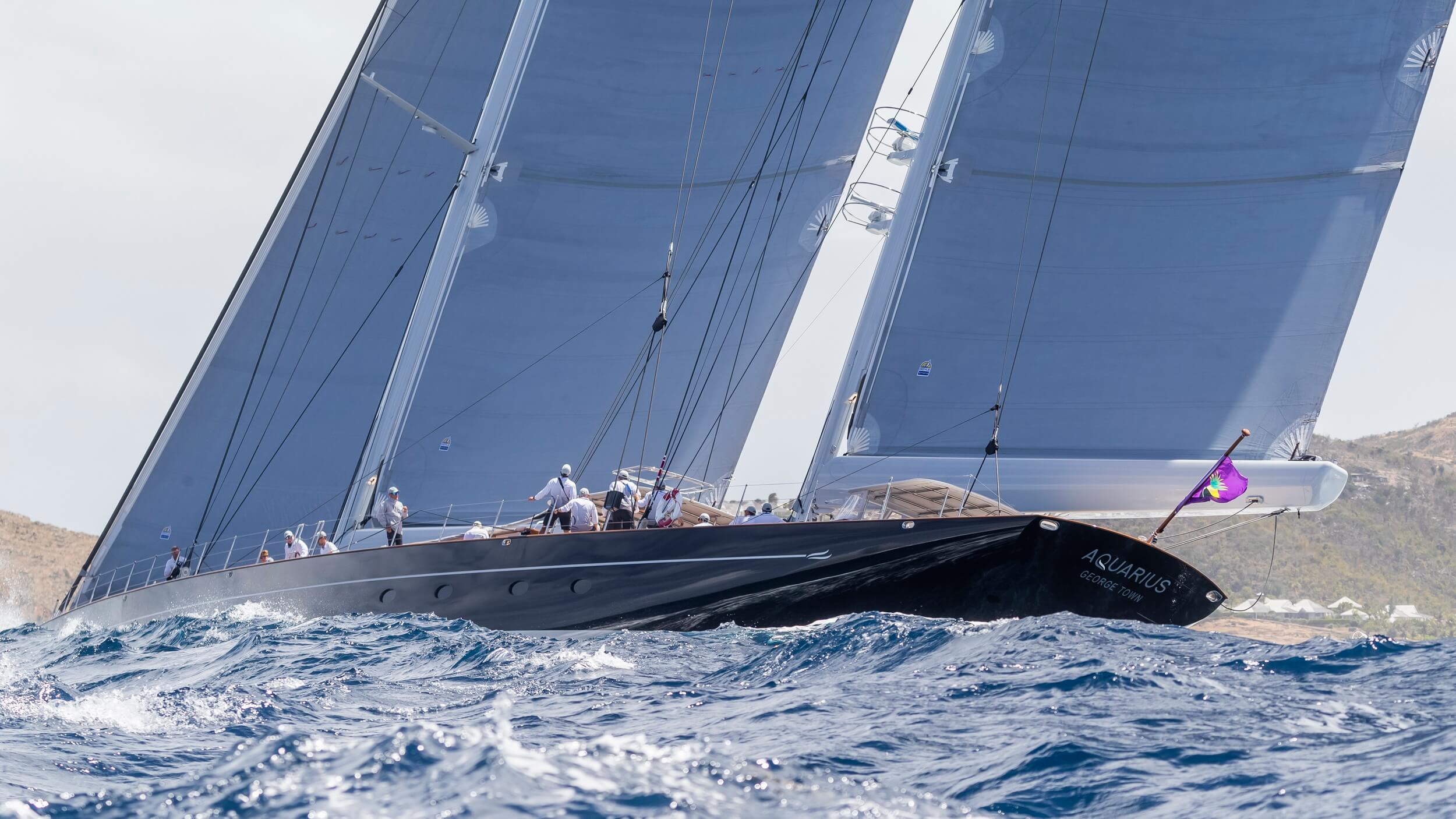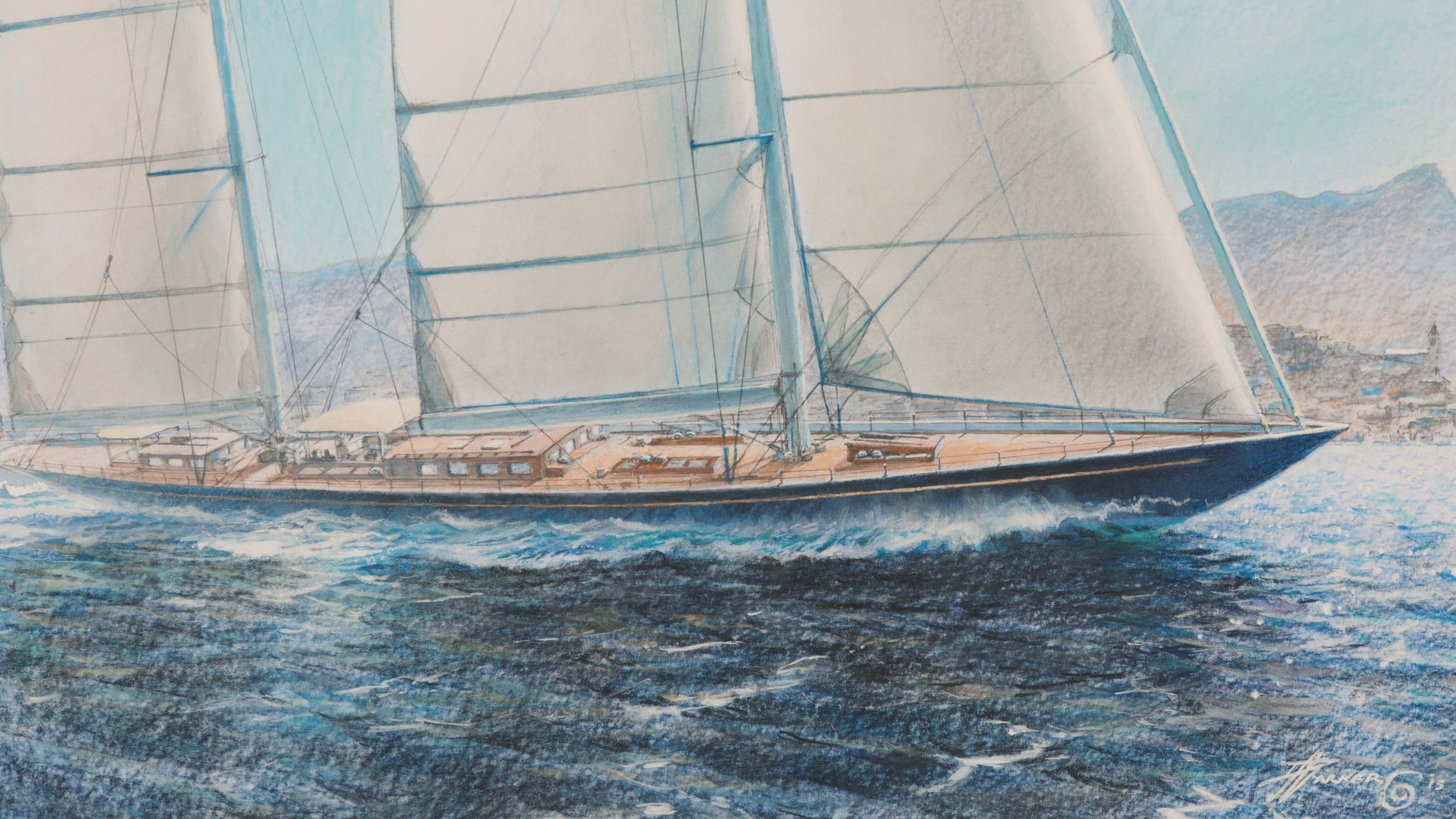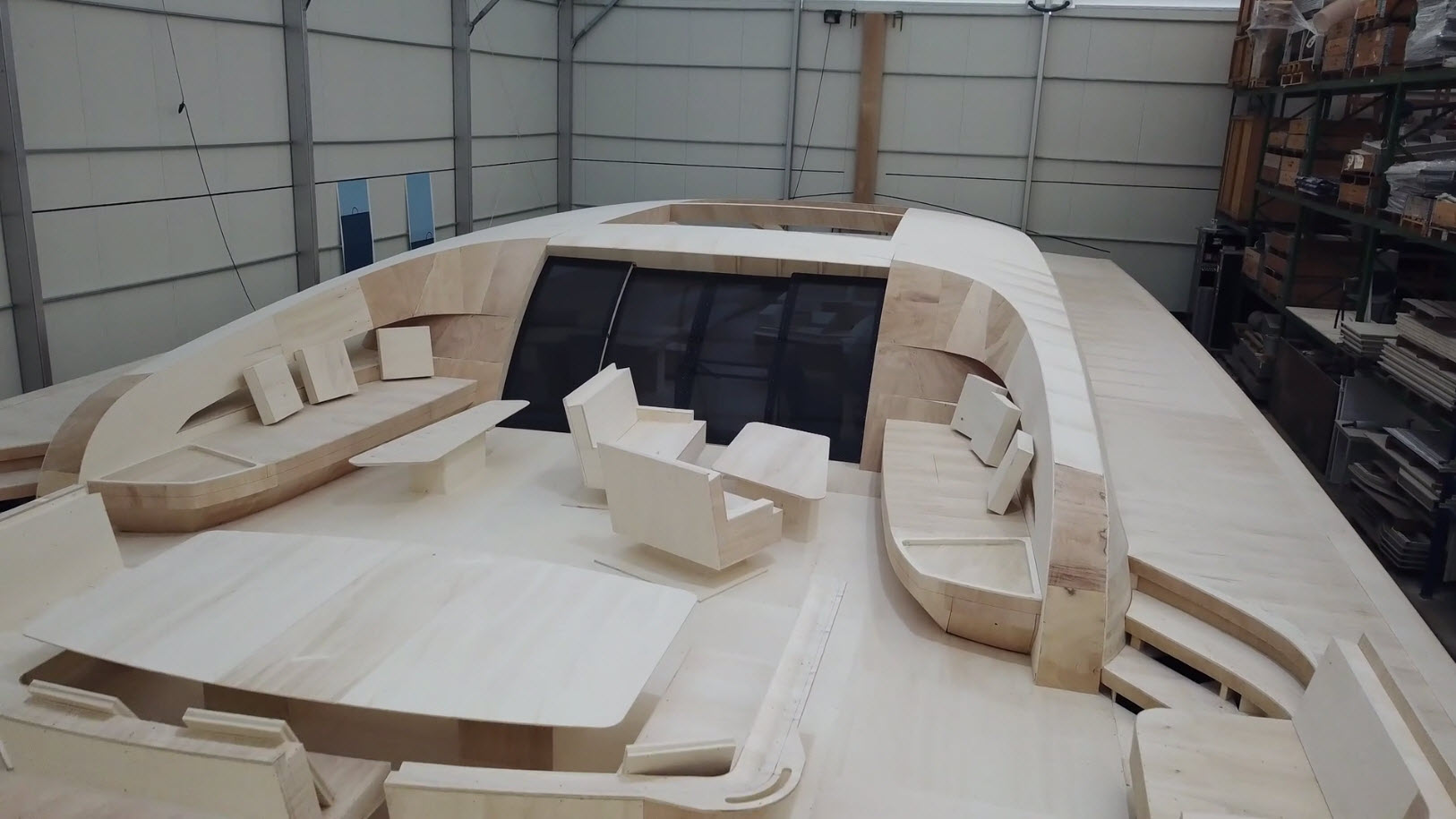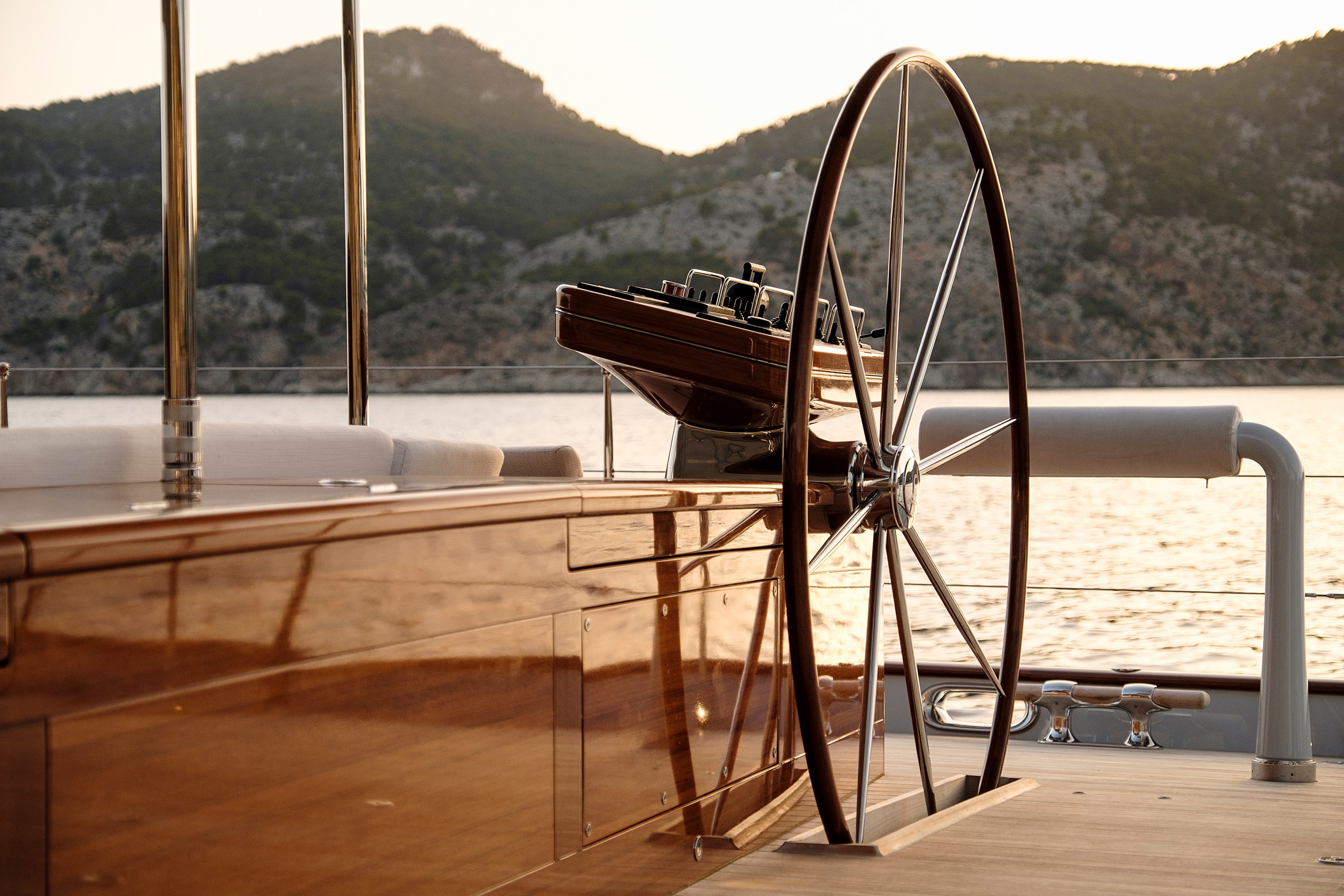In-build at Royal Huisman and scheduled for delivery later this year, 65-metre Aquarius II is so similar in style...
…and spirit to her smaller predecessor that you might think you’re seeing double. But under her modern classic exterior, the custom cruising ketch benefits from literally hundreds of tweaks to enhance operations and improve performance.
11 MIN READ
Article by Justin Ratcliffe published in ‘How to Build It’ magazine by Super Yacht Times, issue 4 spring 2024
Aquarius (I) competing the St. Barths Bucket Regatta: first in ‘Les Elegantes’ class (2019 and 2022)
Launched in 2018, 56-metre Aquarius redefined the modern classic genre. Graceful and understated yet powerful and exciting to sail, she came first in class at her racing debut in the St. Barths Bucket. Aquarius II may be a full nine metres longer, but the ideology behind her design has not changed. “She’s basically the same boat on steroids,” says her captain.
Aquarius II reunites the Dutch shipyard with Dykstra Naval Architects, interior designer Mark Whiteley, owner’s rep Godfrey ‘Goddy’ Cray, and yacht captain James Turner. The latter came to the project armed with a checklist of 728 ‘improvements’ meticulously compiled during five years of sailing the previous yacht. That’s not to say there was anything wrong with Aquarius. Indeed, she was “close to perfect” for her owners and their decision to build bigger was dictated by a growing family and the desire for a fourth guest cabin, more crew accommodation, a larger gym, and generally more space for onboard services such as the laundry and galley.
The checklist deals mostly with technicalities affecting the everyday operation of the vessel, such as the orientation of HVAC drip trays, the position of the fuel tank vents and relocating a hydraulic cooling pump. In other words, the kind of things you can only figure out when the yacht has been sailed a lot. Rather than a catalogue of errors, it was an invaluable inventory outlining how operations, maintenance and comfort could be enhanced.
“All shipyards have their preferred way of doing things, but input like this is beneficial for both parties because we get a better boat at the end of the day and they can incorporate the lessons learnt into subsequent projects,” says the captain.
“New-builds like
this are all about
maintaining
momentum.”
’Goddy’ Cray, captain James Turner, and Dimitri van Zwieten
It’s all about balance
Exhilarating performance was a priority from the start as the owners aim to repeat St Barths Bucket victories in 2019 and 2022 with the new boat. The issue, however, is that bigger doesn’t necessarily mean better in terms of sailing performance.
“The design issue with sloops approaching 50 metres and ketches over 60 metres is that you struggle for sufficient keel draft and sail area,” explains Cray, working on his third Royal Huisman project after Ngoni and Aquarius. “Maintaining the right balance between the two is essential and If either is compromised then performance will be limited, which is why the naval architecture always comes first on sailing boats.”
Unlike her smaller sibling, Aquarius II has a lifting keel with a variable draft from 4.8 to 7.6 metres for access to most anchorages and marinas as well as stability and performance when powered up. The keel trunk, milled from solid aluminium, penetrates the area between the galley and crew mess with only a small impact on interior volume.
Like her predecessor, Aquarius II will have a modern classic styling by Dykstra Naval Architects and matching interior by Mark Whiteley
More complicated was the sail area and mast height. On world cruisers these are restricted by the Bridge of the Americas over the Panama Canal that has a ‘Panamax’ air draft limit of around 62.5 metres. However, it did not escape Cray’s notice when Unfurled, a Vitters sloop with a 65-metre mast, was able to pass under the bridge heeled over by using water bags attached to her rig. With this in mind and taking into account the owners’ request for more interior volume, the design team came up with a proposal for a 61-metre yacht with a 64-metre main mast, plumb bow, bowsprit and submarine anchors.
“We thought we’d ticked all the right boxes, but just to be sure I did a final check with the port authority in Panama,” says Cray. “It turned out they were no longer entertaining a heeled-state transit under the bridge. Oops!”
Pre-assembling the interior furniture. Like Aquarius, Aquarius II will feature a ring of skylights around the mizzen mast in the owner’s suite.
Changing tack
At this point the owners reiterated their commitment to sailing performance, even if it meant going beyond the Panamax limit. They also voiced their preference for a classic spoon bow like Aquarius as opposed to a plumb bow configuration with a bowsprit. No longer constrained by air draft the main mast height was pushed up to 67.5 metres and the hull extended to 65 metres overall.
The extra length means that Aquarius II has nearly 45 percent more interior volume than her predecessor, more than enough to accommodate the extra cabins, guest space and service areas. To better illustrate what this increase in volume signifies in practical terms, Cray produced a table for the owners comparing the main areas aboard both boats. The figures show that the owner’s areas range from 21 to 55 percent larger, the gym nearly 39 percent, the galley 67 percent, and the laundry a whopping three times bigger.
Although less weight means more performance, combining aluminium construction with carbon composite elements as Royal Huisman had done on 60-metre Sarissa would have produced only incremental gains at significant extra cost. Instead, the structural weight was reduced by using FEM analysis to study local loads and vary the size and spacing of the hull frames according to where reinforcement is needed. Combined with Rondal’s fully integrated carbon rig and sailing system (see sidebar), carbon elliptical rigging from Carbo-Link and Doyle’s structured luff sail technology, the result will be an elegant bluewater cruising yacht with a muscular turn of speed for the occasional superyacht regatta.
“Planning is important
because you need
to keep it flowing,
and Royal Huisman
are very good at
doing the groundwork
upfront.
Otherwise the risks
in terms of budget,
build time and reliability
just keep mounting up.”
Video animation of Aquarius II at the St. Barths Bucket
“The slender hull shape, lifting keel and extra mast height means the yacht will be quick around the race course, but also responsive in the light airs typical of the Med,” says Erik Wassen of Dykstra. “With a 400-tonne boat flying more than 2,000 square metres of canvas and sailing with over 16 knots of boat speed, the loads on the rudder are tremendous. It’s a very fine line between having a good feel on the wheel and struggling at the helm, so we put a lot of effort into optimising the rudder shape and balance.”
To further enhance steering responsiveness, US-based Edson Marine was brought in to develop a torque-assisted system that reduces the number of turns of the wheel from lock to lock while maintaining the hands-on ‘feel’ of the mechanical cable and wire steering (see text “Edson Marine” below).
March 2023: the hull turning of Project 408, Aquarius II, in Vollenhove: home to the world’s finest superyacht building
Reducing the risk
Throughout the design and specification process, Cray was attentive to technological developments that might be considered of limited value. Innovations can add function and enjoyment, but they may also come with downsides in terms of time, cost and reliability. “Our goal with Aquarius had been to keep it as simple as possible within the bounds of a luxury yacht,” says Cray. “Given the nature of superyachts that’s a bit of an oxymoron, but it was important to steer away from risky innovations and the same mantra applies for Aquarius II. That said, we have incorporated some current but tested developments.”
One such is the semi-hybrid technology for power generation and management. The hybrid system comprises a 900kW MTU diesel engine for propulsion with a 70kW alternator/shaft generator mounted on the gearbox that can run the hotel loads when the yacht is motoring, and two fixed-speed diesel generators coupled to a 125kW battery bank for peak shaving. Instead of the second generator cutting in during peaks in demand, the batteries can absorb the excess. The system brings efficiency and flexibility benefits as the generators are sized according to energy usage over 24 hours, not the total energy demand at any one time.
The MG Energy batteries are housed in a A60-rated watertight and floodable compartment low down in the hull amidships. In the remote case of thermal runaway, a network of fireproofed pipes help to dissipate the heat outboard. The battery pack can also supply electrical power to the shaft generator to feed power into the grid. All Royal Huisman yachts have a small electric power pack for minor hydraulic functions that is powered in port via the shore converter. The system on Aquarius II offers enhanced flexibility. So when in harbour, for example, the captain doesn’t need to start up the engine or generator to operate the passarelle. Further, the hydraulic system is load sensing and can adjust pressure and flow rate to reflect the requirements of one or more consumers for smoother and quieter operations.
Detail of a fuel valve logged in the shipyard’s construction management software.
Advance planning
Many of the 700-plus items on the checklist of improvements involved the onboard systems. Overseen by Royal Huisman project manager Dimitri van Zwieten, it fell to systems manager Sjoerd Schrichte and lead engineer Richard Daenen to integrate them into the schematics of Aquarius II in consultation with the crew. As part of the shipyard’s custom build approach, it was then routed into its proprietary construction management software that logs all the system components according to type, function, location and ‘skid’ number (the system racks that are pre-assembled for subsequent plug-and-play installation). The result is a complete guide to how the onboard systems have been designed and executed in case of repair or replacement in the future. The data is also routed into Navisworks, a 3D modelling program that can track seamlessly through exterior and interior net spaces and is used across all departments to review the project in build.
In addition, Royal Huisman has long embraced product development and management methodologies such as Concurrent Engineering and Stage-Gating to ensure complex projects don’t get bogged down by the sheer number of decisions that have to be made and solutions found. Involving multiple disciplines simultaneously rather than consecutively, and breaking projects into a series of stages with decision ‘gates’ helps to keep the ball rolling.
“New-builds like this are all about maintaining momentum,” concludes Cray. “Planning is important because you need to keep it flowing, and Royal Huisman are very good at doing the groundwork upfront. Otherwise the risks in terms of budget, build time and reliability just keep mounting up.”
Edson Marine
Rudder feedback is the grail of a highperformance steering system and the compelling advantage of mechanical steering systems. While hydraulic steering provides power, it does so at the cost of eliminating feedback to the helm. However, the high loads of sailing superyachts require mechanical systems to use high gear ratios to make steering loads manageable, commonly resulting in 8-10 turns of the wheel from hardover to hard-over. This means small course adjustments require a lot of wheel movement.
This was the conundrum Edson Marine was looking to resolve with its new powerassisted steering system, displayed at METSTRADE last year and being fitted for the first time on Aquarius II. After looking at electric power-assisted steering systems in the automotive industry, the US-based company designed its own solution with a software package developed specifically for large sailboats whose steering systems are loaded up in one direction for much longer periods compared to cars.
“The system basically comprises an electric motor with a gearbox that is driven by a torque sensor between the wheel and the rudder,” explains Edson’s president, Chip Johns. “That sensor measures how much torque the helmsman is putting on the wheel and the data is sent to the control software, which decides whether to add or subtract load. It’s a variable system with five levels of assist.”
With just one torque tube instead of two, the Edson system already reduces weight and friction, providing an incremental improvement to the mechanical steering on Aquarius II. The power-assist function is a separate module engineered to add 140 Nm (Newton Metres) or about 103.25 ft-lb of torque. In practical terms, if 20 kg of rim load are required to turn the wheel, the system is able to reduce the loading to around 5 kg and make a 4-turn lockto- lock manoeuvre as easy as 10 turns using conventional mechanical assistance, all without losing the feel of the rudder.
“It’s not just about racing in the St Barths Bucket, because the system will make it easier for owners – as well as their friends and children – to enjoy cruising on a prolonged reach, for example,” says Johns. “Whatever we can do to make the sailing experience more enjoyable is good for the owner and good for the industry.”
Aquarius’ performance furling booms by Rondal
The Rondal rig
The high-modulus carbon rig and integrated sail handling by Rondal is another area that has benefitted from close consultation with the crew and the lessons learned from operating the previous boat. More than a scaled-up version of the rig on Aquarius, the state-ofthe- art system introduces additional refinements for pushing the yacht hard under racing conditions with a crew of 30 while also being able to cruise safely with minimal numbers of permanent crew.
“The primary design variable is mast stability, which is driven by local and global buckling,” says Edoardo Volpe, Rondal’s project lead engineer. “Mast stability is optimised by engineering the mast tube section size, shape and by controlling the stiffness properties of the laminate, including fibre type and direction, to keep the weight low while complying with classification. The secondary variable is mast tuning or trimability.”
Aquarius has checkstays and runners for modify mast bend controlling the shape of the mainsail, but Aquarius II makes use of deflectors to control mast bend and stability. More effective than checkstays as they pull back laterally instead of downward, deflectors also reduce drag to enhance racing performance. While in cruising mode deflectors are locked at a certain position, like checkstays, to make rig handling easier with a short-handed crew, also in reefed conditions.
Aquarius II’s carbon main and mizzen mast under construction at Rondal
Another improvement is the continuous carbon elliptical rigging from Carbo-Link. Structurally, this is exactly the same as Carbo-Link’s round-section cables and just as strong, but the elliptical shape provides better aerodynamics and less windage when sailing or at anchor, which means less vibration. Carbon rigging is susceptible to resonance that can be surprisingly noisy – an important consideration when the mizzen mast passes through the owner’s suite and the mizzen forestay is the longest and skinniest exposed stay on the boat.
The higher mast meant that the masthead could be designed with better separation between the forestay and Code 0/A3 sails for easier handling when racing. Cruising superyachts tend to leave the Code 0 up as crews are getting smaller and handling big free-flying sails (ie. sails attached to the rig only through their corners) can be a messy and sometimes dangerous business. Sensors measuring mast compression and loads on runners, deflectors, forestays and main sheets provide real-time feedback.
Additionally, Rondal shares its software with Doyle Sails so they can run both the sails and the rig through the same program to see how the spars and rigging behave. “Loads are getting higher and captains are more reluctant to fully trust their own sailing experience,” says Volpe. “Part of our job is to give them as much information as possible so they know how best to handle the rig.”
Main specifications
Aquarius II | Royal Huisman project 408 | type: Performance Ketch | length: 65m / 212ft | owners’ project manager: Godfrey Cray | naval architecture + exterior styling: Dykstra Naval Architects | interior design: Mark Whiteley Design | construction: Alustar® aluminum | rig + handling: Rondal carbon rig + Integrated Sailing System

